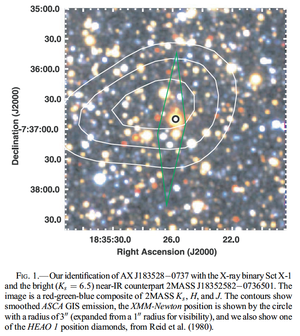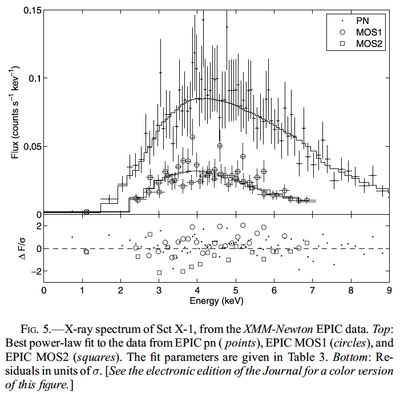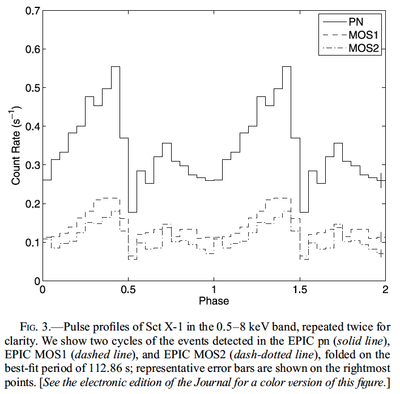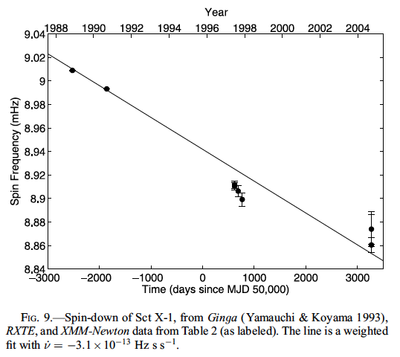Difference between revisions of "Scutum X-1"
(Created page with "Also known as: 3A 1833-078 [http://simbad.u-strasbg.fr/simbad/sim-id?Ident=Sct+X-1+&NbIdent=1&Radius=2&Radius.unit=arcmin&submit=submit+id Simbad] '''Monitoring Data''': [ht...") |
m (Kuehnel moved page Sct X-1 to Scutum X-1) |
(No difference)
| |
Latest revision as of 11:48, 18 April 2018
Also known as: 3A 1833-078 Simbad
Monitoring Data: [1]], [Swift/BAT
Coordinates
| RA | 18h 35' 25.83" | DEC | -07° 36' 50.1" |
Binary system
Distance
Determined by [1]: ~10 kpc
Orbit
Period: known upper limits ([2]):
For Mcomp = 13 M⊙ and Rcomp = 500 R⊙ : Porb > 2 yr
For Mcomp = 1.2 M⊙ and Rcomp = 100 R⊙ : Porb > 0.8 yr
Optical Companion
Names : 2MASS J18352582-0736501 ([2])
Type : Red giant or red supergiant ([2])
The figure below was obtained from [2].

Available data
- XMM-Newton: 30 ksec observation of close by radio pulsar (Oct 2005)
- Chandra: HRC-I image of AX J183518-0754 (3 ksec)
- RXTE: < 20 ksec observations (Aug 1997); part of Galactic Bulge Monitoring (C. Markwardt)
- ASCA: 20" off-axis obsevartions <30ksec in Galactic Ridge Monitoring (Apr 1994, Oct 1997)
- BeppoSAX: GRB observations close by
Description
Sct X-1 is symbiotic X-ray binary discovered by a sounding rocket ([3]).
It is an eclipsing system at a distance of ~10 kpc ([1]), composed of an accreting pulsar ([4]) and a near-IR counterpart, a late type giant or a supergiant.
The position of the x-ray source was found with XMM-Newton data ([2]).
The X-rays are most likely due to wind-fed accretion or due to an elliptical orbit ([2]).
Flux
Between 0.5 and 10 keV, Sct X-1 has a luminosity of 1.4 x 1033 d2kpc ([2]).
Spectrum
The source has a hard spectrum with a low-energy cutoff and an photon index ranging between 1.5 ([5]) and 2.0 ([2]), and a variable absorption from 0.8 x 1022 cm-2 ([5]) to (2 - 4) x 1023 cm-2 ([2]) in the low energy band. These variations in absorbtion are associated with the stellar wind accretion ([2]). It is not clear yet if there is an iron K fluorescence line at 6.4 keV ([5], [2]).
The figure below was obtained from [2].

Pulse Profile
Sct X-1 shows a pulse period of: 112.86 ± 0.08 sec ([2]).
The figure below (obtained from [2]), shows the double-peaked pulse profile.

Pulse Period Evolution
The source has had a steady spin down rate of 3.9 x 10-9 s s-1 averaged over 17 yr (see figure below obtained from [2]).
References
- ↑ 1.0 1.1 Koyama, K., Kawada, M., Kunieda, H., et al., 1990, Nature, 343, 148 (NASA ADS)
- ↑ 2.00 2.01 2.02 2.03 2.04 2.05 2.06 2.07 2.08 2.09 2.10 2.11 2.12 2.13 2.14 Kaplan, D. L., Levine, A. M., Chakrabarty, D., et al., 2007, ApJ, 661, 437 (NASA ADS)
- ↑ Hill, R., Burginyon, G., Grader, R., et al., 1974, ApJ, 189, L69 (NASA ADS)
- ↑ Yamauchi, S., Koyama, K., 1993, PASJ, 45, 449 (NASA ADS)
- ↑ 5.0 5.1 5.2 Koyama, K., Kunieda, H., Takeuchi, Y., et al., 1991, ApJ, 370, L77 (NASA ADS)
